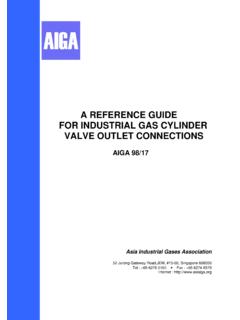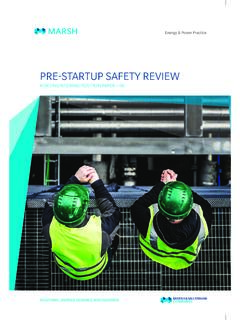Transcription of AIGA 056 14 Safe practices guide for cryogenic air ...
1 safe practices guide FOR cryogenic AIR SEPARATION PLANTS AIGA 056/14 Based on CGA P-8 -2013 Fifth Edition Asia Industrial Gases Association 3 HarbourFront Place, #09-04 HarbourFront Tower 2, Singapore 099254 Tel : +65 62760160 Internet : Reproduced with permission from Compressed Gas Association. All rights reserved. ASIA INDUSTRIAL GASES ASSOCIATION 3 HarbourFront Place #09-04 HarbourFront Tower 2 Singapore 099254 Internet: AIGA 056/14 safe startup AND shutdown practices FOR steam REFORMERS Disclaimer All publications of AIGA or bearing AIGA s name contain information, including Codes of Practice, safety procedures and other technical information that were obtained from sources believed by AIGA to be reliable and/ or based on technical information and experience currently available from members of AIGA and others at the date of the publication.
2 As such, we do not make any representation or warranty nor accept any liability as to the accuracy, completeness or correctness of the information contained in these publications. While AIGA recommends that its members refer to or use its publications, such reference to or use thereof by its members or third parties is purely voluntary and not binding. AIGA or its members make no guarantee of the results and assume no liability or responsibility in connection with the reference to or use of information or suggestions contained in AIGA s publications. AIGA has no control whatsoever as regards, performance or non performance, misinterpretation, proper or improper use of any information or suggestions contained in AIGA s publications by any person or entity (including AIGA members) and AIGA expressly disclaims any liability in connection thereto.
3 AIGA s publications are subject to periodic review and users are cautioned to obtain the latest edition. NOTE Technical changes from the previous edition are underlined. AIGA 056/14 PAGE iii Contents Page 1 Introduction .. 1 2 Scope .. 1 3 Typical ASU features .. 1 4 Definitions .. 3 5 Health hazards .. 8 cryogenic liquids .. 8 Gas products .. 8 Asphyxiation .. 8 Oxygen hazards .. 9 Protective clothing and personal protective equipment .. 10 6 General plant considerations .. 10 Site selection .. 10 Safety factors in plant layouts .. 10 Materials of 11 Insulation other than coldbox .. 12 Cleaning .. 12 Electrical requirements.
4 12 Noise .. 13 7 Intake air quality .. 13 Contaminants .. 13 Reactive contaminants that concentrate in oxygen .. 14 Reactive contaminants that concentrate in nitrogen .. 15 Plugging components .. 15 Haze and smoke from 16 Contaminant 16 Identification of contaminants .. 17 Location of air intake .. 17 Monitoring intake air .. 17 8 Compressors .. 17 Axial compressors .. 17 Centrifugal 18 Other dynamic compressor considerations .. 18 Reciprocating compressors .. 19 Diaphragm compressors .. 21 Rotary positive displacement compressors .. 21 Refrigerant gas compressors .. 21 Screw compressors .. 21 Lubrication systems .. 21 Coolers and separators .. 23 Suction filters or screens .. 23 Special considerations for oxygen service .. 23 Operating and maintenance procedures .. 24 9 Air contaminant removal.
5 24 Removal 24 Contaminant removal stages .. 25 Prepurification unit operation .. 27 REVEX operation .. 29 Supplemental mechanical chillers .. 31 Caustic scrubbers .. 32 AIGA 056/14 PAGE iv 10 Expanders .. 32 Loss of loading and 32 Oil contamination of the process .. 33 Abnormally low temperatures .. 34 Solids in gas stream .. 34 Loss of 34 Abnormal bearing temperature .. 35 Abnormal 35 Abnormal speed .. 35 Critical speed .. 35 Fouling of expander with ice or carbon dioxide .. 35 startup and 36 Operating and maintenance procedures .. 36 11 cryogenic pumps .. 36 General .. 36 Types of pumps .. 37 Materials of 37 Pump system design.
6 37 Special considerations for oxygen service .. 38 Pump motor .. 38 Pump operation .. 39 Operating and maintenance procedures .. 39 12 Coldbox .. 39 Removing particulate material .. 40 cryogenic adsorbers .. 40 Liquid levels .. 41 Monitoring contaminants .. 42 Argon separation and purification .. 43 Noncondensable purge .. 44 Coldbox cleaning .. 44 safe holding time for LOX .. 44 Liquefaction of air in the main heat exchanger .. 44 Process upsets .. 44 13 Control systems .. 46 Instrumented systems functions .. 46 Critical safety systems .. 46 Operational safety systems .. 47 Routine plant operation control systems .. 47 Unattended or partially attended operation .. 48 Remote operation .. 48 Additional considerations for computer-based control systems .. 48 Additional considerations for failsafe systems.
7 49 Alarm system .. 49 Regulatory considerations .. 50 14 Product handling equipment .. 50 Liquid storage .. 50 High pressure gas storage vessels .. 51 Liquid vaporizers .. 52 15 Cooling systems .. 52 16 Plant piping .. 53 General design considerations for plant piping .. 53 General design considerations for check valves .. 53 AIGA 056/14 PAGE v Oxygen piping hazards .. 53 Pressure relief devices .. 53 cryogenic piping .. 54 Dead legs .. 55 Carbon steel 55 Venting .. 55 Product delivery .. 56 17 shutdown procedures .. 56 Coldbox shutdown .. 56 Liquid and gas disposal .. 56 Plant derime .. 57 18 Repair and inspection .. 58 General maintenance considerations.
8 58 Supervisory control .. 58 Special construction and repair considerations .. 58 Coldbox 58 Hazards of working in oxygen-enriched or oxygen-deficient atmospheres .. 59 Cleaning .. 59 19 Operations and training .. 60 Operating procedures .. 60 Commissioning procedures .. 60 Emergency procedures .. 60 Management of change .. 60 Personnel 61 20 References .. 61 Figure Figure 1 Representative air separation plant flow diagram .. 2 Tables Table 1 Effects at various oxygen breathing levels .. 9 Table 2 Plugging, reactive, and corrosive contaminants in air .. 13 Table 3 Typical default air quality design basis .. 14 Table 4 Typical removal in PPU process .. 26 Table 5 Typical removal in REVEX process .. 26 Table 6 cryogenic adsorber names .. 40 AIGA 056/14 PAGE 1 1 Introduction As part of a programme of harmonization of industry standards, the Asia Industrial Gases Association (AIGA) has adopted the Compressed Gas Association (CGA) standard P-8, 5th edition.
9 This international harmonized document is intended for use and application by all IHC member associations. The AIGA edition has the same technical content as the CGA edition, however, there are editorial changes primarily in formatting, units used and spelling. Also, references to regional regulatory requirements have replaced US regulations where appropriate. This publication provides guidance on the safe operation of cryogenic air separation plants. It is based on the experience of CGA member companies that operate cryogenic air separation units (ASUs). Industrial cryogenic air separation has some potential hazards that must be recognized and addressed. The hazards include electricity, gases under pressure, very low temperatures, the ability of oxygen to accelerate combustion, and the asphyxiant properties of nitrogen, argon, and the rare gases [1].
10 1 cryogenic air separation technology is not static; it has been progressing for decades and will continue to do so because of engineering development efforts. Consequently, plant process cycles, equipment, and operating conditions can be and are of varying kinds. Therefore, this publication must include generalized statements and recommendations on matters for which there is a diversity of opinion or practice. Users of this guide should recognize that it is presented with the understanding that it cannot take the place of sound engineering judgment, training, and experience. It does not constitute, and should not be construed to be, a code of rules or regulations. 2 Scope This publication serves the interest of those associated or concerned with air separation plant operations and applies to safety in the design, location, construction, installation, operation, and maintenance of cryogenic air separation plants.














